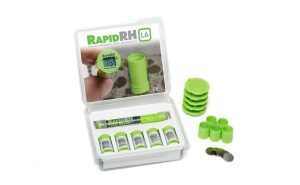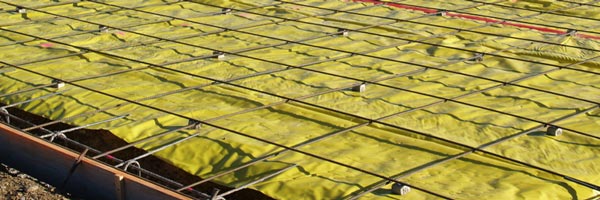Moisture Mitigation Systems: Prevention and Defense from Moisture-Related Flooring Problems
The cost of moisture-related flooring problems should be deterrent enough to send any flooring professional looking for solutions. It’s estimated that every year approximately one billion dollars are spent on flooring-related failures due to moisture.
Signs of Trouble
Typical symptoms of high moisture levels interfering with installed floors may include:
- blistering
- bubbles
- delamination or adhesive failure
- warping
- crazing
- scaling
- pop-outs
- efflorescence
- discoloration
- gaps or cracks
- swollen joints
- mold or mildew growth
In flooring, as with so many other industries, “the best defense is a good offense”, and proactive steps in the planning and installation stages can protect the final floor over time.
The First Line of Defense
The best preventative measure for moisture-related problems in flooring is time; time for the concrete subfloor to dry adequately, and time for wood flooring to acclimate fully. Time is required to allow moisture levels to reach the tolerances of the materials specified. With some exceptions for certain subgrade conditions (i.e. high groundwater levels), establishing realistic timelines and including testing for accurate moisture conditions prevents a significant number of moisture-related flooring problems.
 However, as we so often hear, time is money, and builders increasingly find themselves spending money to mitigate problems time would resolve. Tight project schedules and the demand for maximized production mean that moisture mitigation systems have become more readily-used to manage moisture conditions in a slab, prior to flooring installations.
However, as we so often hear, time is money, and builders increasingly find themselves spending money to mitigate problems time would resolve. Tight project schedules and the demand for maximized production mean that moisture mitigation systems have become more readily-used to manage moisture conditions in a slab, prior to flooring installations.
Moisture Mitigation Options
Moisture mitigation systems exist to limit the impact of moisture on installed floors and to reduce the risks of moisture-related problems. Think of it as flooring insurance; the cost up front can offset potential disasters down the road.
Essentially, the purpose of any moisture mitigation system is to limit or eliminate the movement of water vapor into the flooring system. This may include water vapor from exterior sources like groundwater, or moisture vapor from a subfloor system itself, such as off-gassing from an insufficiently dry concrete slab. Regardless of the source, high moisture levels will move from high concentration areas to low concentration areas until it reaches a state of equilibrium. Interrupting that natural process is the key to preventing moisture-related complications.
Any efficient moisture mitigation system may involve a number of elements:
Vapor Retarders
Vapor retarders or vapor-retarding membranes provide a preformed layer that is put in place between a subgrade and a poured concrete slab. However, sometimes these layers are recommended above the slab for other types of flooring applications, typically under absorbent flooring types like wood or laminate. Vapor retarders have different “perm ratings” that identify the level of permeability they provide between various flooring layers. Some are also designed to prevent certain gases from transmitting along with water vapor.
Surface Membranes/Applied Barriers
This category includes epoxy primers, sealers, and sheet membranes that are applied to/on a concrete slab or subfloor to reduce the permeability between sub floors and final flooring applications. There are also acrylic latex resins or cementitious layers that create this non-permeable layer to prevent moisture migration. It is generally recommended that installers use the product recommended by the flooring manufacturer to ensure proper installation and performance.
Adhesives
Like applied surface membranes, there are many flooring adhesives out on the market that are said, by the different manufacturers, to be able to withstand higher levels of moisture. Utilizing these products, in some cases, can be a good proactive solution.
The key to success for any mitigation product or adhesive is proper installation techniques. Always follow the manufacturer’s guidelines.
Moisture Testing
It’s critically important to know accurate moisture or RH levels in the subfloor before and during the flooring installation project.
 For concrete subfloors, Relative Humidity (RH) testing provides the best indicator of the slab’s RH level, informing the project scheduler when the subfloor is ready for flooring installation. It can also assist in determining the proper flooring product selection for the job site. Everything from the initial concrete mix to the job site environment contributes to what the RH levels in the concrete slab are, and only RH testing can provide reliable answers.
For concrete subfloors, Relative Humidity (RH) testing provides the best indicator of the slab’s RH level, informing the project scheduler when the subfloor is ready for flooring installation. It can also assist in determining the proper flooring product selection for the job site. Everything from the initial concrete mix to the job site environment contributes to what the RH levels in the concrete slab are, and only RH testing can provide reliable answers.
For any installed floor, if the installer does not measure and plan for potential moisture problems in advance of installing the flooring, there can be a potential for a future flooring failure. However, with sufficient planning, and if proper moisture measurement tools are used, including the right moisture mitigation system, and/or in some cases, more moisture-resistant adhesives, the installed floor can last a lifetime.
For further reading:
- http://www.wagnermeters.com/pdf/moisture_mitagation.pdf
- https://www.concretemoisture.com/design/understanding-the-influence-of-vapor-retarders/
